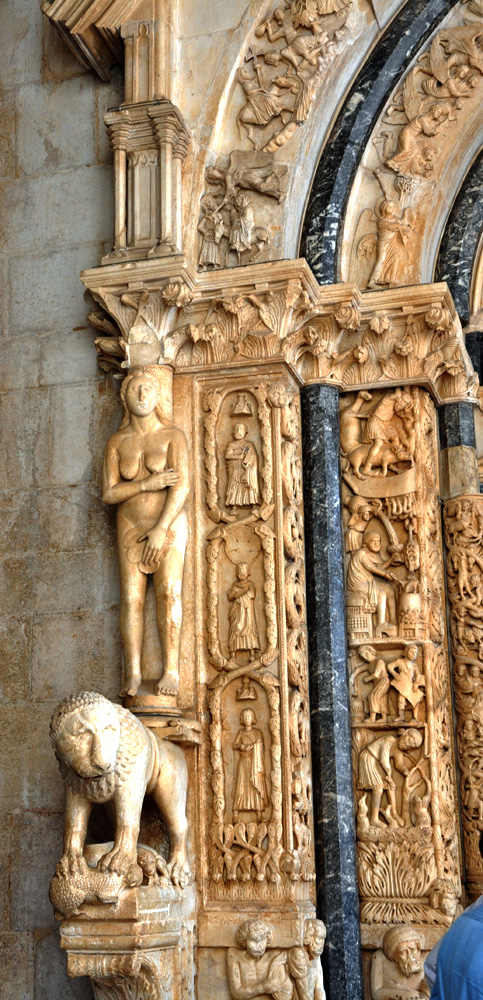The two lions, each with a victim in its clutches, are the most direct assertion of these perils. As explained in my page on lion symbolism, lions flanking entrances refer to Christian commentaries on the lions in the Psalms, whose victims are interpreted variously as the martyrs or as humans whose moral destruction is the aim of the enemy. The victim of the lion on the right is a bird, traditional symbol of the human soul. On the left it is a lamb, a symbol of both Christ and the individual Christian. This double signification carries through the entire composition: the world presents a moral peril to the soul of the unwary Christian, but it also presents the prospect of physical martyrdom, of a salvific death like Christ's.
Adam and Eve are portrayed in striking life-size statues – not naked as in prelapsarian Eden but holding fig leaves over their shame. They are the "old man" of Paul's epistles, who brought death into the world.
 The inner columns are a commentary on that death. At the top on the left a farmer slaughters a pig. The next panel down has a butcher making the pig's meat into sausage, and below that two cooks prepare the sausage over a fire. The final panel is damaged, but the man in it seems to have had an axe or other implement in his right hand, perhaps to gather the wood for the fire above. Last of all,
at the bottom
two unfortunates and a frowning Saracen and Jew totter under the weight of the columns – a bit of nativist cruelty, certainly, but also a comment for the people of this city on the heavy burden one carries without faith.
The inner columns are a commentary on that death. At the top on the left a farmer slaughters a pig. The next panel down has a butcher making the pig's meat into sausage, and below that two cooks prepare the sausage over a fire. The final panel is damaged, but the man in it seems to have had an axe or other implement in his right hand, perhaps to gather the wood for the fire above. Last of all,
at the bottom
two unfortunates and a frowning Saracen and Jew totter under the weight of the columns – a bit of nativist cruelty, certainly, but also a comment for the people of this city on the heavy burden one carries without faith.
On the right, the inner column has a man at the top shearing a lamb with a long knife and a Roman soldier brandishing a sword below while a "wild man" from folklore acclaims him. The soldier's sword echoes the knife, and thus the death of the martyrs echoes the fate of the lamb. The positive meaning of the lamb's death in turn reflects on the pig's, which one can take as a symbol of either frightening moral destruction or a salvific transfiguration like Christ's, who said, "the bread that I will give, is my flesh" (John 6:52).
The innermost columns present a variety of creatures from nature and from legend: on the left a mermaid, an ostrich, a centaur, and a strange creature with the head of a beast, the wings of a bird, and the long tail of a serpent. On the right are a deer, a goat, a camel, an elephant, a bear, and a griffin attacking a pig. All together, these creatures evoke the natural world, but not in a romantic or "charming" way. Rather, in their variety and their strangeness they are like Yeats's "fish, flesh, and fowl" that "commend all summer long whatever is begotten, born, and dies."
As a whole, then, the columns assert, first, that moral perils abound in the natural world, and second, that physical peril can be salvific when in the context of a martyrdom that dies with Christ.
In counterpoint to this theology of peril the two columns of saints (probably apostles)1 rise to the tympanum's narrative of Jesus' life, death, and resurrection – all forming an assurance of the resurrection that awaits the Christian who has endured the perils below. Then finally, at the very summit, we see the patron of the cathedral, the martyr St. Lawrence and his gridiron.
View the left image in full resolution.
View the right image in full resolution.
Read more about the lion symbol and the lamb symbol.
Read more about images of Adam and Eve.

